How to make a walking staff in three easy steps

Sean Fagan of Pioneer Bushcraft sets out how to make a walking staff, and why they’re the best friend to have with you in the great outdoors.
Easy and quick to make, a good walking staff can be made from start to finish in as little as 5-10 minutes. I’m a big fan of walking staffs, and for good reason – the benefits are many.
Here are a few…
- Improve balance and posture when walking which can prevent injuries when walking across uneven, challenging terrain.
- Assist with the ability to walk with a leg injury.
- Clearing away vegetation (especially vegetation that hurts – such as thorny plants).
- Assist in ascending or descending steep land – when ascending steep land a sturdy staff assists the legs muscles by engaging the upper body muscles. A staff also greatly assists in maintaining balance and posture when descending steep land (which prevents slipping and falling).
More obscure uses include knocking off tree fruit to dislodging limpets off rock to digging up edible roots.
A walking staff is also a good investigative tool. Whether that’s examining fox poo while tracking or testing for marshy ground underfoot while hiking, a walking staff is a good way of investigating stuff we would rather not touch or step into.
How to make a walking staff in 3 easy steps
Step 1: wood selection
The first step is to look for a branch that is straight-as-possible, sturdy and relatively light.
In Ireland and Britain and throughout large tracts of Europe the two following, relatively common, and widespread tree species are particularly good for producing straight, sturdy branches.
- Willow, salix spp.
- Hazel, corylus spp.
These tree species were often traditionally coppiced to produce straight branches for various uses. Often the branches of these trees are straight grained with few, mostly small knots – making them very strong.
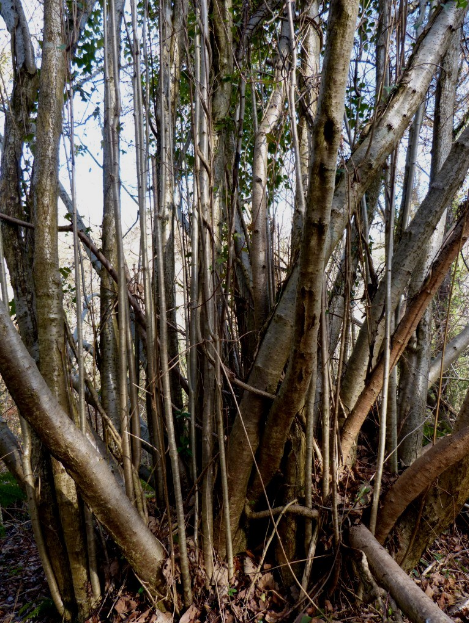
Although hazel and willow trees are two of the most ideal trees for making staffs, do not become unnecessarily focused on these two tree species for optimal wood selection – any suitably long, strong, straight(ish) and wieldy branch will do.
An absence of knots is an advantage as they are a source of structural weakness in wood. However, it’s not that necessary to have a knot-free branch as long as the knots are small (1 cm or less in diameter).
Once you have spotted a suitable branch, I recommend that you cut the branch with a saw as close as possible to the trunk of the tree. Try to cut a branch that is at least thumb thick at its widest point (where the branch meets the trunk) and at least a foot taller than yourself.
I prefer to cut down branches with a saw, as a saw will leave a very flat cut (which facilitates the healing process of the severed branch stump).
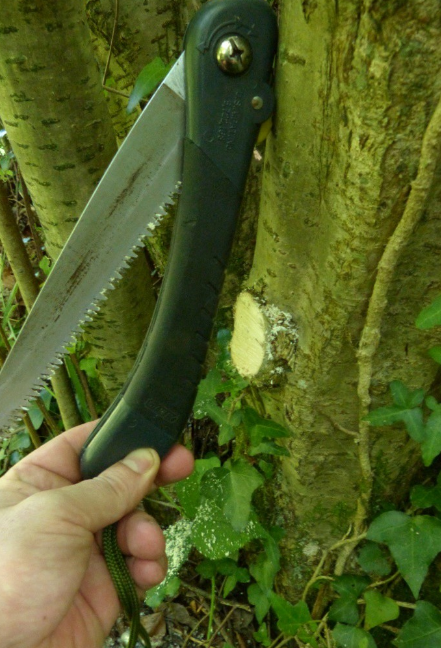
Before cutting down the branch, give it a long, lingering look and ask the following questions…
- Does it look healthy and strong enough to support my weight? (look for any infected wood that is discoloured and soft (punky)). There is no harm at this point in giving the branch a good pull to test its strength.
- Is it straight enough?
- Does it look light enough to be used for long periods of time?
By asking these questions before cutting down a branch you potentially save yourself time and wasting valuable natural resources. You will also develop and hone your eye for the potential of branches/wood in general (always a good skill to develop).
If you do cut down a branch which proves to be unworthy, save that branch for other projects – such as tent stakes or the legs of a cooking tripod.
Step 2: selecting the correct length of branch & measuring up
One of the most essential features of a walking staff is that it can be held short or long and still be effective when walking on steep land.
When descending steep land it’s often necessary to hold the staff long in order for the staff to reach the sloping land in front of the walker. Conversely, when ascending steep land it’s often necessary to hold the stick short – to enable the stick to be used effectively as a walking support.
In terms of width – the top end of the staff should be about thumb-thick – about 1-1 ½ inches (2.54 cm – 3.81 cm).

However, a staff that is thumb-thick at the top is a generic measurement guide.
Some woods are dense and heavy, and making a staff about 1 ½ inch wide at the top might be a little too heavy and cumbersome to use for long periods of time. Conversely, some woods are light and not that strong, and may need to be wider than thumb-thick at the top of the staff to ensure it has sufficient strength.
Don’t be shy about experimenting with this aspect of the project. In time, and with enough practice, you will be able to quickly assess the potential of any branch by acquiring a general familiarity with the unique timber properties of different tree species.
In terms of length – select a branch that about 1 foot higher (30.5cm) than yourself. This will ensure that the selected branch is strong throughout its length and prevent the possibility of prematurely making a walking staff that is too short.
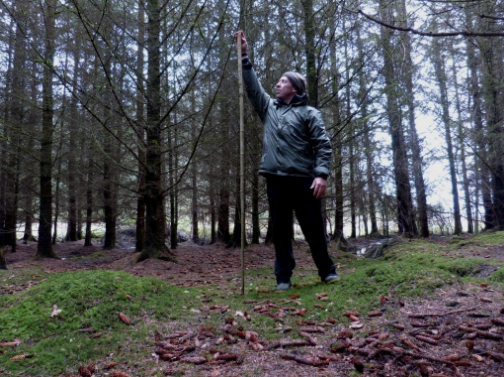
Measuring up…
You now have a branch that is about thumb-thick at its widest point and about 1 foot longer than your body height.
Now it’s time to cut the branch to a length that suits you.
- Stand with the thick end of the branch on the ground (not the thin end of the branch!)
- Hold the branch in such a way that your elbow is to your side and your forearm is parallel to the ground (see photo below).
- With your knife or even your thumbnail, make a small nick in the bark about 2-3 inches above your hand (in photo below, note where my finger is pointing on the branch).
- Cut off the branch at this point.
- If using a knife to make this cut, I recommend using either the forehand grip or scissor grip to cut the branch to length. Alternatively, use a saw or an axe.
- The length of the staff should now be about ground level to bottom-of-sternum height.
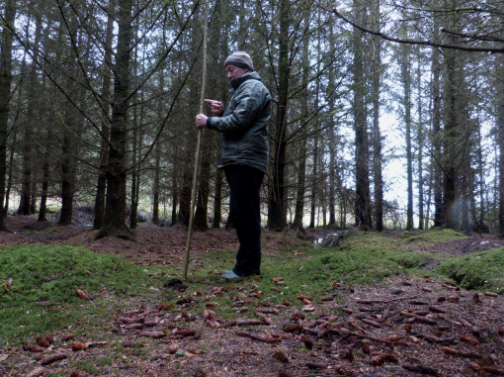
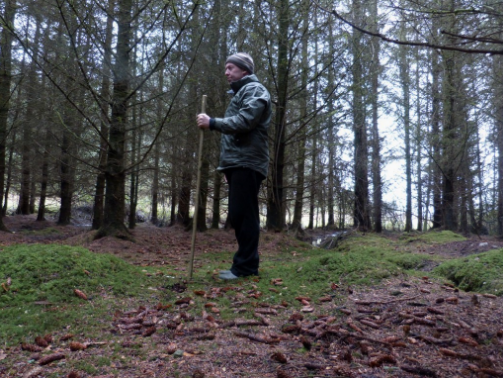
Step 3: rounding off the ends
Rounding both ends of the staff will make the wood more resistant to splitting.
The best knife grip for creating a rounded effect is the scissor or chest-lever grip (see 3 mins 28 secs of video link: chest lever grip).
Rounding off the top end of the staff provides a comfortable surface for the palm of the hand to rest upon when using the staff as long as possible – such as descending steep land when you may need to hold the staff in the palm of your hand so the staff maximises your reach.
Repeat the rounding off process on the bottom end of the staff – this will make the thin end of the staff more resistant to splitting.
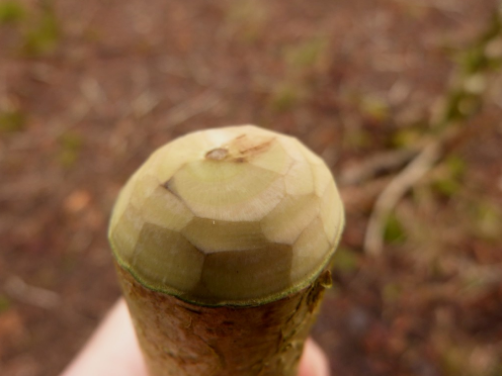
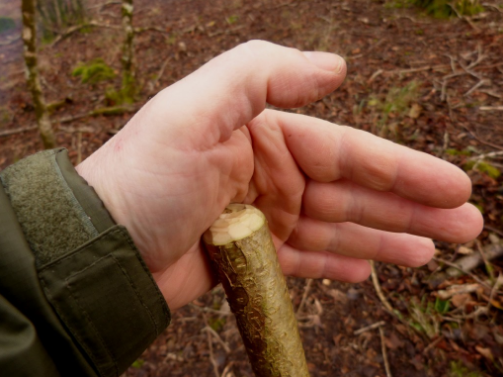
Making the staff lighter but still retaining strength
To debark or not to debark?
Some people like to debark the staff to expose the pale prettiness of the wood. Personally, I like to blend in with nature as much as possible and prefer the staff to retain its bark.
However, I often take off a thin strip of the wood from top to bottom to hasten the drying of the wood. The trapped water within the wood of the branch can now easily evaporate through the thin strip of debarked wood.
You can rub some dark soil or mud onto the thin, pale strip of debarked wood if you want your staff to retain its natural, dull-coloured camouflage.

Seasoned wood is lighter. In time, as the staff seasons it will become significantly lighter while still retaining its strength.
When freshly cut, green living wood can be surprisingly heavier than seasoned wood (with many tree species having a moisture content of up to 45%-50% of the weight in water).
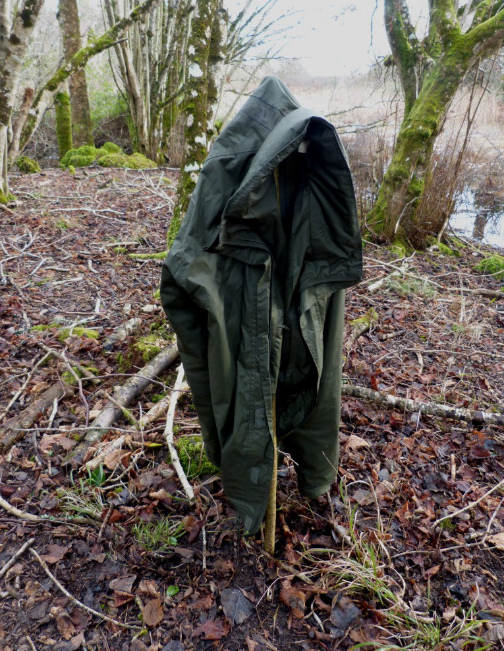
A good walking staff is a joy to use. Like a good friend, it’s always ready to help out and come to your aid. I like the fact I can easily fashion one from a suitable tree whenever I need one. That’s always a good feeling.
All photos are the author’s own. Find the original post on the Pioneer Bushcraft blog.
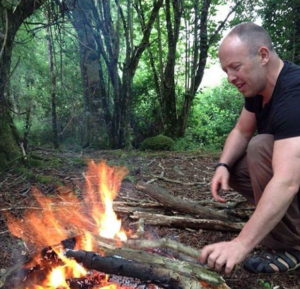 About the author
About the author
Sean Fagan is a bushcraft, nature and adventure enthusiast. He blogs at Pioneer Bushcraft and can be found on Twitter @PioneerIreland.
The views expressed in our blog are those of the author and not necessarily lowimpact.org's
2 Comments
-
1Clive Walker September 11th, 2023
Dear Sean,
I stumbled across, (probably not the most appropriate term when talking about hiking poles!), your post about three steps to stick making on the Web recently.
I harvest Hazel poles from our 400 year old ancient coppice at West Horsley Place (Surrey - you'llneed to google it...) to create carved poles which we sell in the shop to help provide much needed income.
I'm running a day course soon for novice stick makers and wondered if I could share your piece as the most succinct presentation I've yet found.
Needless to say all with credits to you and pointers to your Web site etc.
I will understand if you say no but would be delighted if you say yes.
Many thanks
-
2Sean Fagan September 13th, 2023
Hi Clive, feel free to use my article. Glad you liked it, best regards - Sean.




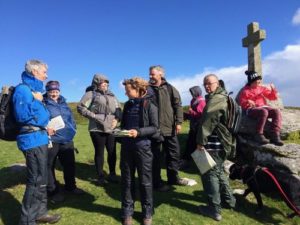 Why I walk: a conversation with a walking guide
Why I walk: a conversation with a walking guide
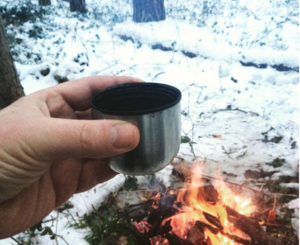 7 great reasons to try bushcraft and camping in winter
7 great reasons to try bushcraft and camping in winter
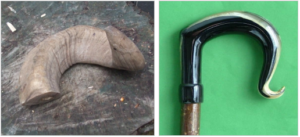 Step by step stickmaking: how to craft a ram’s horn crook
Step by step stickmaking: how to craft a ram’s horn crook
 For the love of trees: my musings on trees
For the love of trees: my musings on trees
 Why cycling and walking are great for your mental health
Why cycling and walking are great for your mental health
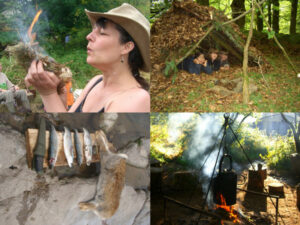 Bushcraft
Bushcraft
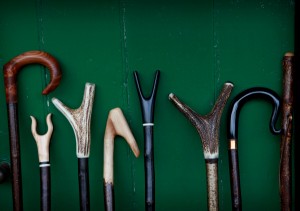 Sticks & crooks
Sticks & crooks
 Walking & hiking
Walking & hiking


